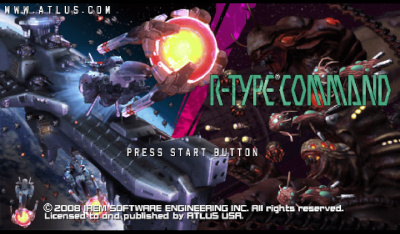
R-Type Command (PlayStation Portable) Review
~by tankMage (July 2025)
Score: 8/10 (Good)
Great concept, imperfect execution.
I’m a sucker for tactical RPGs and R-Type is my favorite shooter franchise, so it was difficult for me to approach R-Type Command from a point of neutrality. Even now, I’m tempted to bump the score of this game up a bit, but I have to remind myself that it has a few foibles. At the same time, it’s outstanding for a handheld, so that counts for something.
At any rate, R-Type Command is a TRPG that has players moving units from the famous shump franchise around on a hex board and thinking, rather than mashing buttons. Making a game like this was a brave move on Irem’s part, because the overlap between shmup and TRPG fans must be fairly small. In fact, the sequel never saw the light of day in North America, so it’s likely this title only sold well in Japan. If you’ve played a tactics game before, you’ll be familiar with the formula R-Type Command uses, though it also has fog of war, which is more of an RTS thing.
Playing around with units from the R-Type franchise was fun and they were able to translate the shmup into a TRPG fairly well. It was also fun unlocking and collecting units. On the other hand, the menus were not the best and there were some strange design choices, like using a side view instead of a top-down perspective. Yeah, I know the shooters are sidescrollers, but Tactical RPGs use top-down almost exclusively for a reason. Even with its faults, this title is cool.
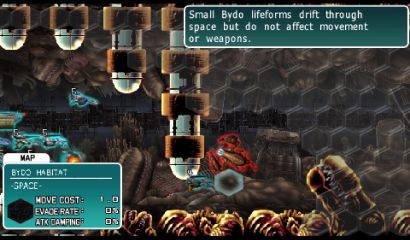
Wait, there’s a story?
I’ve played several of the R-Type titles over the course of my life and even managed to beat a few of them. I was never really aware of there being a premise to the series aside from a spaceship that blows up creepy aliens called Bydo. Though, I will say that R-Type Final expanded on the game’s lore a bit with its huge roster of ships and cutscenes.
Well, somehow they managed to squeeze a decent story out of the series that doesn’t get in the way of the action, which is something a lot of TRPGs can’t claim. Players are also free to read or ignore the story which is told in a series of journal entries. I’ve always liked this approach and enjoyed the journal entries. There were also a few cutscenes and I thought they were very well done. Even better, the cutscenes weren’t overly long and used the “show, rather than tell” method of getting the point across.
Despite being simple, there are some surprises in the story and it builds on the premise of the series very well. Overall, I have to give Irem credit for coming up with a decent plot.
The world’s first sidescrolling Tactical RPG!
As much as I like this game, its side perspective does not work very well. In fact, it unbalances the game and leads to some really weird situations. For example, units cannot turn to face the opposite direction. This may sound trivial, but front firing charge weapons are a big part of this game and the series in general. Consequently, there are many situations where R-Type fighters, which are the very soul of the series, are pretty much useless. The issue becomes especially pernicious in vertical levels were players have to zigzag through tight spaces. Even worse, players who realize that certain units do not need to face the enemy in order to be effective can really abuse the system.
As much as it hurts the game, the side view isn’t all bad. For one thing, it made it possible to create some interesting levels, like a fire planet where the player has to avoid plumes to lava. It’s also true that the original R-Type games were side scrollers and some of the graphical assets would not have translated well into other formats, though this could have been easily fixed by using an isometric perspective.
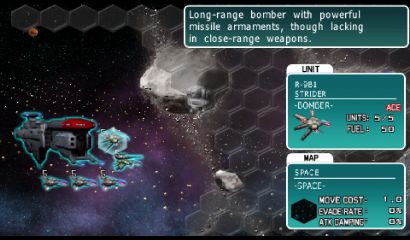
Solid Tactical Combat
Irem did a good job on the combat. There are 57 missions in total, which is fairly beefy. Most missions have a simple “destroy the enemy flagship” objective, though a few differ from the norm. Being turn based, the game lets one side have a full turn where they move all of their units, then the other side gets a turn. Missions have a strict turn limit (usually 35 turns) where the player fails if he doesn’t complete the objective before reaching the limit. The player must also designate one of his or her larger units as a flagship before the start of every mission. This makes the game a bit more challenging, since you have to keep your flagship alive if you want to win.
Everything is laid out on a hex map, which makes the layout of the maps feel more organic. It also adds nuance to combat, because a lot of weapons have blind spots in which you or the enemy can hide.
The wide array of units available to the player are the star of the show. Players can unlock dozens of spaceships, all from the series. These range from R series fighters to bipedal units to huge dreadnoughts. It’s even possible to attach Force Units to many of the fighters and use them to power up your weapons or ram enemies.
I should probably point out that some units are way overpowered. It doesn’t take much practice to figure out which units are the best and to use them to steamroll the game. That said, R-Type Command gives players enough freedom to choose not to use the overpowered units, so it’s fine in my book. Plus, there are plenty of different strategies creative players can come up with and I only got to try a few of them.
In the end, it was R-Type Command’s solid gameplay that won me over. Even after 57 missions I wanted more, though I will say the game sagged in places where the missions weren’t very inspired. Luckily the good missions outnumbered the boring ones.
Graphics
R-Type Command is inconsistent in terms of graphical quality. A lot of the assets used on the hex maps are very bland and unimpressive. The explosions are poor and look a bit like something from a late 2000s phone game. Then there’s the combat animations and cutscenes which look marvelous. A mini-cutscene will sometimes play when one unit attacks another. These combat scenes are beautifully done, right down to the backgrounds, which reflect the unit’s position on the map. I was thoroughly impressed by these scenes, but they get old after a while. Luckily they can be skipped or turned off entirely.
I also loved the cutscenes that played at certain points in the story. They really brought the game to life and did the franchise justice. However, the movies looked kind of blurry and grainy, but I liked the effect.
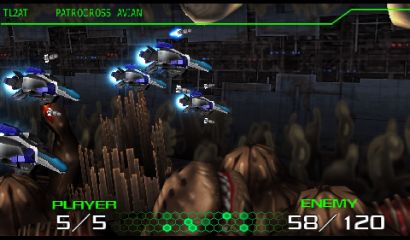
Uh… what button do I push… where are my units?!
The menu layouts and descriptions were the worst aspects of this game. It’s difficult to explain, but I had a hard time going through the unit and pilot menus between missions. This is likely because the unit roster also serves as the unit development menu and does not indicate which units have a pilot assigned to them. Plus the pilot roster does not show what units are available until the player tries to reassign a pilot.
To make the situation even more confusing, building new units was a vague process. Players need to gather resources (a subject I’ll cover later in this review) and items called Spoils, which were often hidden on mission maps. Straightforward right? Well, the game does not do a good job of telling players that some units are technically upgrades of older ones and the player will lose the older version of a unit after upgrading it.
For example, if you have a Vanargand Cruiser and you upgrade it to a Garum, the Vanargand will go away. This may seem obvious, but the only thing indicating the Vanargand gets consumed is a little picture of the unit under required materials. It’s right under the required spoils and easily missed or misunderstood, especially since spoils don’t get consumed when the player makes a new unit. I spent nearly half the game wondering why some of my units were going missing and why I could not produce certain units even though I had the resources and spoils for them. A development tree or some other type of menu would have worked better for this game.
I also found it a bit too easy to accidentally hit the wait command when shuffling units around in battle. This is mostly my fault for rushing, but it is something players have to watch out for. The movement system is also pretty weird. For some reason, a unit will follow the exact path traced by the player’s cursor, which means you can basically get units to double back on themselves while moving. This serves no real purpose from what I can tell, but it does make it possible to waste large amounts of fuel if you’re not careful when directing your fleet.
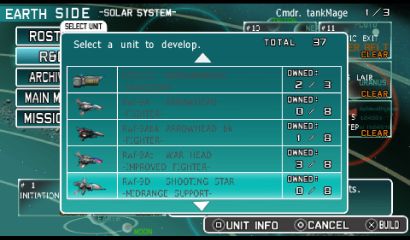
Grinding and Mining
One thing I didn’t expect to encounter in a tactics game is mining. Yep, mining, as in extracting resources from a mineral deposit underground… though in this case the resources are in asteroids for the most part. To mine an asteroid, you need to have a Craft Module in your fleet and you have to move it to a mineable asteroid, then you have to select the Salvage command. Asteroids have a finite supply of resources and the Craft Module has limited cargo space, so you’ll probably spend some time mining if you want to build your fleet up. In fact, I had to repeat a mission about six or seven times to build my fleet up in the middle of the game.
I’ll be honest, I did not enjoy replaying old missions in search of space ore so I could build better units and the mining feature doesn’t fit well with the genre anyway. Most TRPGs give players money or resources that can be used to purchase new units at the end of each battle, which works out better in my opinion.
Criingggg, Criingggg, Criingggg
Here’s the part of the review where I talk about the music and sound effects. Guess we’ll start with the music, which wasn’t much more than wallpaper. To be fair, some of the songs, particularly one of the Bydo themes and the track that plays during the credits, were really good. I’m really not sure why they didn’t just remix some of the songs from the older games, particularly R-Type 1, 2, and Super R-Type, which all had great soundtracks. Then again, it’s possible the music in this game was based on one of the games I didn’t play. If that’s the case, they picked the wrong game.
The sound effects were faithful to those of the franchise, so I can’t complain about them…except for one. This game has what I call the “Criingggg” sound effect. You know, that sound that is kind of reminiscent of a the sword clash sound they used to put in cheesey movies. Usually it doesn’t bother me, but it’s really loud in this game for some reason. It also plays constantly, like every time you enter a command. It gets annoying after a while and it would have been nice if they toned it down a bit.
Is R-Type Command right for you?
As TRPGs go, R-Type Command is above average, but far from great. That said, the fact that it is based on the R-Type series is a good reason to play it. There’s a lot of features that make it unique and even the story is interesting enough to merit a playthrough. Just be ready to deal with the issues I mentioned in this review.
Thanks for reading my R-Type Command review!
RetroMaggedon.com ©2025
